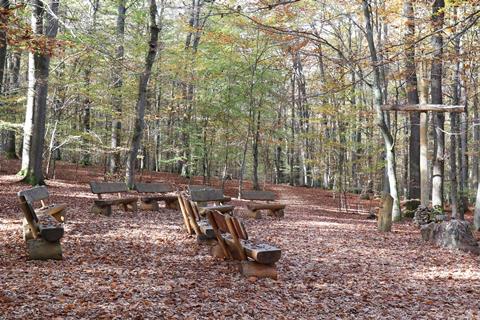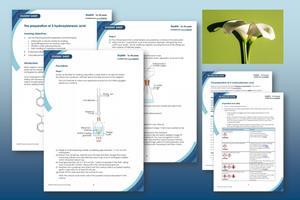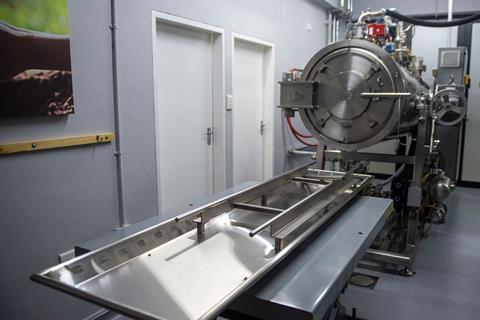Does chemistry have the answer to greener and more sustainable burials and cremations?
Every year, around 650,000 people in the UK die. This is not just a personal tragedy for the families concerned, but also a major problem when it comes to how bodies are handled – including both respect for remains and the person’s beliefs, but also in terms of pollutants and environmental impact. It’s why people are turning to chemistry to ask if it’s possible to have a greener and more sustainable way to manage our environmental footprint after death.
Considering what to do with a loved one’s remains is nothing new, explains James Holloway, an archaeologist based in Cambridge, who specialises in Anglo-Saxon burial rites. ‘Some people were cremated, some were buried and you also get excarnation. Different cultures, such as the Zoroastrians [from Persia], would often expose the bodies of the dead so they would be scavenged. We know that in Britain a body was often put in one place, where it decomposed and then the bones were collected and redeposited somewhere else.’
Unfortunately, James adds, it’s hard to say why this was done in the past. ‘With burials or any kind of funerary practice,’ he says, ‘the spiritual and practical go hand in hand. They influence each other and it’s very hard to point at anything and say it’s done purely for religious or practical reasons.’
In your class
Water cremation involves the alkaline hydrolysis of esters, and is greener than flame cremation. This technique is also used in the preparation of salicylic acid, which is a step in the preparation of aspirin and is commonly practised by 16–18 year-old chemistry students. Use this article alongside the accompanying resource to demonstrate how to apply chemistry techniques in multiple contexts.
Green burial?
Burial might seem a relatively unpolluting option. After all, it’s a natural process, involving a host of chemical changes, as well as direct digestion of the corpse by other organisms. Decomposition takes place in two ways: autolysis, where digestive enzymes break down carbohydrates and proteins; and putrefaction, caused by bacteria, which is responsible for the smell. This occurs in several different stages, including butyric fermentation, in which butyric acid is formed, and the build-up of hydrogen sulfide gas.

If a body isn’t buried quickly, these gases can cause it to explode – as happened at the funeral of William the Conqueror in AD 1087. Corpses are often embalmed to prevent decay and avoid this. However, embalming fluids can contain substances such as formaldehyde – a potential environmental pollutant if it leaks from the coffin. In the US, that equates to about 16 million litres of embalming fluid potentially contaminating the soil every year.
There are other potential pollutants in a burial – such as the person’s clothes and the materials used. Business Insider found that every year in the US 30 million foot of hardwood, 2700 tonnes of copper and bronze, 104,272 tonnes of steel, 1,636,000 tonnes of concrete and four million acres of forest go into producing coffins and headstones. It was a problem the ancients recognised, says James. The Twelve Tables, the earliest written laws from Ancient Rome in the 5th century BC, include details about what can be buried with a body – including whether to remove gold teeth fillings. Throughout history, many coffins have contained heavy metal pollutants, such as lead linings. The first Qin Emperor in China – famous for being buried with an entire army in the form of the Terracotta Warriors – is said to have been buried under a literal river of mercury.
A green, or woodland, burial is one way to minimise contamination. This is done by burying the person in a natural environment, without embalming and with the body wearing biodegradable clothes and placed in a biodegradable coffin. Usually, the only commemoration is a tree grown in their honour – in theory, creating a new ecological habitat, adding to sustainability.
Many would object to their loved one’s remains being poured down the drain as a green-brown liquid
However, Julie Rugg, a senior research fellow at the University of York and director of the Cemetery Research Group, isn’t convinced green burial is the best solution for everyone. ‘It’s a death-style choice,’ she says. ‘I don’t think it has a substantial impact because the numbers are quite small. The issue is scale: it’s very land intensive. The idea is that graves are not disturbed again and that the land becomes a lovely, wonderful forest or meadow. But you’ve got to remember, we’ve got another 600,000 people a year dying; this is not an option we can scale up to accommodate everybody. We’re not just thinking about carbon footprint; we’ve got to think about sustainability, too.’
Ashes to ashes
Julie suggests there’s a better target for reducing a funeral’s carbon footprint: cremation. In the UK, around eight in ten funerals involve cremation, usually using a gas flame to heat the coffin to around 1000°C. This results in a substantial carbon footprint. The Cemetery Development Services group estimates that, for every gas-powered cremation, around 245 kg of carbon is released into the atmosphere, creating a carbon footprint of about 115,150 tonnes every year in the UK.
And carbon isn’t the only thing being released into the atmosphere: burning a body (and its clothes and coffin) produces harmful emissions, including sulfur dioxide (SO2), nitrogen oxides (NOx) and volatile organic compounds, with benzene comprising about 45% of the compounds released, followed by acrolein, acetone, ethanol and toluene. One of the greatest dangers to health comes from our teeth: mercury is often used in dental amalgam and gets released into the atmosphere in potentially dangerous quantities. One study estimated about 1.2 g of mercury was released per body cremated in British Colombia, Canada – producing an estimated 36 kg of mercury in the atmosphere, or 7% of the province’s entire mercury pollution.

Download this
Alkaline hydrolysis practical, for age range 16–18
Water cremations are a type of alkaline hydrolysis, a technique that is also used in organic synthesis. Help your learners improve their practical skills with this worksheet, which gives full instructions for the preparation of 2-hydroxybenzoic acid from oil of wintergreen.
Resources include:
Download this
Alkaline hydrolysis practical, for age range 16–18
Water cremations are a type of alkaline hydrolysis, a technique that is also used in organic synthesis. Help your learners improve their organic practical skills with this worksheet, which gives full instructions for the preparation of 2-hydroxybenzoic acid from oil of wintergreen using Quickfit® apparatus.
Download the resources from the Education in Chemistry website: rsc.li/49EygJa
This means alternatives to flame cremation are also being touted, including moving away from gas fires. ‘There’s been a lot of discussion about whether it’s possible to move to biofuels or electricity,’ Julie explains. ‘But at the moment, when you talk to cremation managers, they’re quite resistant. It’s almost a feeling only gas will do the job.’
There’s also the question of what to do with the remains. Ashes can be pollutants too, which has led to some dramatic options. ‘In China, the biggest thing happening at the moment is [the scattering of ashes at sea],’ says Julie. ‘Bodies are cremated and then the ashes are scattered at sea. The Chinese government has now said this is almost a duty of citizenship. But I don’t know; do we really want to be putting things in the sea [without considering environmental impact]? I would hold back on that for now.’

Water cremation
A potential alternative to flame cremation is alkaline hydrolysis, also known as water cremation – a technique that’s already been used for the bodies of famous figures such as Desmond Tutu. Instead of a typical flame cremation, the body is placed in a water tank containing an alkali solution, such as potassium hydroxide, at a ratio of about 5% chemical to 95% water. This is then heated to around 160°C, under intense pressure. Proteins and fats in the body are hydrolysed, producing soluble salts of amino acids from the proteins and soluble salts of fatty acids, plus glycerol from the fats.
Water cremation essentially speeds up the natural processes that would cause a body to decay over several years into a matter of hours. The option doesn’t destroy bones (or dental fillings), though, which can then be broken into powder and scattered like ash.
The real climate challenge when it comes to the dead isn’t the body – it’s how it’s remembered
There are a few drawbacks to this method, however: a single corpse requires around 1500 litres of water for the process (although this is surprisingly little for a modern treatment works to handle and wouldn’t affect our waste system). And there’s still the question of how to treat the individual with respect. Although all that’s left of the body is a solution of sugars, amino acids and peptides, many would object to their loved one’s remains being poured down the drain as a green-brown liquid. Perhaps a bigger concern is that the solution is pH 11 and a possible contaminant.
Water cremation is already legal in the UK, although it’s not used widely and would require crematoriums to invest in the expensive equipment required. ‘Part of the issue,’ Julie adds, ‘is that we’ve got a lot of very well-established infrastructure. We’ve been replacing crematoriums for the past 15 years or so and the idea of changing them again to a new set of regulations? People are going to be quite resistant.’
More resources
- Complete our aspirin screen experiment, an interactive simulation of the synthesis of aspirin that features the same practical techniques used in the alkaline hydrolysis activity accompanying this article.
- Use this demonstration to show the effects of acid and alkali on living tissue as well as the formation of soap from hydrolysed fat.
- Investigate the rate of hydrolysis of urea and assess your learners’ practical skills while linking fertiliser usage with the UN sustainable development goals.
- Meet Mike, a sustainability manager, who works with businesses and chemists to advise them on being more green through effective recycling and sustainable processes.
More resources
- Complete our Aspirin screen experiment, an interactive simulation of the synthesis of aspirin that features the same practical techniques used in the alkaline hydrolysis activity accompanying this article: rsc.li/3SBKMDm
- Use this demonstration to show the effects of acid and alkali on living tissue as well as the formation of soap from hydrolysed fat: rsc.li/3FXSqAe
- Investigate the rate of hydrolysis of urea and assess your learners’ practical skills while linking fertiliser usage with the UN sustainable development goals: rsc.li/3umORRz
- Meet Mike, a sustainability manager, who works with businesses and chemists to advise them on being more green through effective recycling and sustainable processes: rsc.li/3MLh1fE
Memento mori
But the real climate challenge when it comes to the dead isn’t the body – it’s how it’s remembered. ‘Traditional burial is often seen as something that doesn’t necessarily have a carbon footprint,’ Julie says. ‘But what about particular funeral practices? What if you’re shipping stone from all the way across the world to make the headstone? Isn’t that problematic? That’s the big puzzle. We’ve got a cultural imperative to allow people religious expression, but at the same time we’ve got to arrive at a more sustainable funerary footprint. And these things don’t agree with each other.’

This is nothing new, James says. Think about the Qin Emperor’s Terracotta Warriors, which was one of the largest art projects ever commissioned and required dozens of workshops and thousands of workers to be brought to life. Perhaps it’s telling that some of the most recognisable monuments in the world – the Pyramids of Giza in Egypt, or the Taj Mahal in India – are funeral monuments.
And even if there isn’t something left to mark the dead, it doesn’t mean the funeral was carbon-neutral. ‘Think about the funeral of Winston Churchill,’ James adds. ‘His grave is just marked by a simple headstone in his local village church, with the date of his birth and death. But he had this elaborate state funeral, with a procession through London involving crowds, TV and film crews – it was a huge deal.’
So, while there are greener alternatives for how to get rid of a body, perhaps the real answer to mitigating the environmental impact of funerals doesn’t just sit with the dead – it’s a matter for the living, and remembering our loved ones in a restrained, respectful way.
Article by award-winning science journalist Kit Chapman. Resource updated by Martin Bluemel and Sandrine Bouchelkia from the Aspirin book.















No comments yet